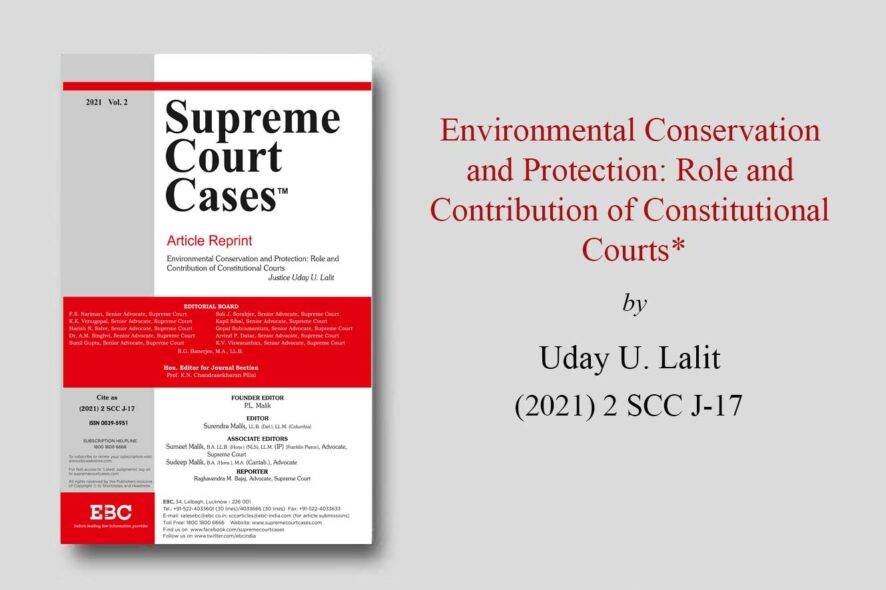When we actually think of and speak of the role of constitutional courts, let us see the change in ethos. We all know that the Forest Act, 1927 was essentially to exploit the natural wealth so that it could be put to greater use. Many of us must have seen the vehicle factory at Jabalpur. Why was it installed at Jabalpur? Jabalpur is known for deep forest jungles. So in order to have vehicles, which were essentially meant to carry the canons of the British forces, a factory was established at Jabalpur so that it became easier to exploit the natural wealth and put it to use by the integral part. That was the Forest Act.
Ethos changed in 1980 when the Forest (Conservation) Act came in 1972. In 1976, amendments were made in the Constitution and Article 48-A was added. For the first time there is now a statement in the Constitution that the State shall endeavour to protect the environment, forest and the wildlife. The chapter on fundamental duty added Article 51-A(g), which is again to the same tune and spirit that every citizen shall protect the environment. This was in 1972. Then the Water Pollution Act and other Acts actually started. In 1980, came the Forest (Conservation) Act, 1992, the Rio Declaration — again the international community — now chisels all the thoughts. The polluter pays1 and other principles are actually vintage of that. As Deepak Gupta, J. said, if this case is one of 1980, perhaps I think that must be the first case on environmental issues. I used to think that in the judgment of Bhagwati, J. in that Rural Litigation2 and judgment of Chinnappa Reddy, J. in Sachidanand Pandey3 where the first sort of illuminating passages and commentaries on environmental issues came, but that was at the Supreme Court level. I am so glad that this case of 1980 was actually in the name of my own colleague. That was a great day for him.
Let us see the first stage where the development actually begins. If we read the judgment of Bhagwati, J. Rural Litigation2 — it does not quote anything. It does not say that so and so passage from so and so book. It simply refers to one committee, which is the Bandyopadhyay Committee Report and then he builds everything on his individual ideas and philosophy. It is the greatest contribution from one of the legal luminaries of this country. So regarding Rural Litigation2, a question was posed by Bhagwati, J. to himself that very well if we actually are going to do away with limestone quarry in Doon Valley, will it not affect the existing leases; will it not affect the monetary prospects; will it not have the financial impact on all those persons, who have an existing contract; and he could set very pithily in one sentence and says if that be the price to protect the environment, he actually says about the protection of the environment and that is where the path was actually set by those two judgments.
READ COMPLETE ARTICLE HERE
*The article has been published with kind permission of Eastern Book Company. Cite as (2021) 2 SCC J-17
* Eighth Lala Amar Chand Sood Memorial Lecture.
† Judge, Supreme Court of India.
1Indian Council for Enviro-Legal Action v. Union of India, (1996) 3 SCC 212.
2Rural Litigation and Entitlement Kendra v. State of U.P., (1985) 2 SCC 431.
3Sachidanand Pandey v. State of W.B., (1987) 2 SCC 295.
4T.N. Godavarman Thirumulpad v. Union of India, (2002) 10 SCC 606.
5Ram Singh v. State of U.P., 2012 SCC OnLine All 573; Court on its Own Motion v. State of Maharashtra, 2011 SCC OnLine Bom 1421; Thilakan v. Circle Inspector of Police, 2007 SCC OnLine Ker 134; Rakesh v. State of Rajasthan, 2011 SCC OnLine Raj 2988; Naveen Chandra Pant v. State of Uttarakhand, 2017 SCC OnLine Utt 389.
6M.C. Mehta v. Kamal Nath, (1997) 1 SCC 388.
7Vellore Citizens’ Welfare Forum v. Union of India, (1996) 5 SCC 647.
8ADM, Jabalpur v. Shivakant Shukla, (1976) 2 SCC 521.
9M.C. Mehta v. Union of India, (1998) 6 SCC 63.
10T.N. Godavarman Thirumulpad v. Union of India, (1997) 2 SCC 267.
11T.N. Godavarman Thirumulpad v. Union of India, (2014) 6 SCC 150.







